Sussex art
Celebrate sixty years of Sussex through highlights of our on-campus art.
Day’s Rest, Day’s Work mural
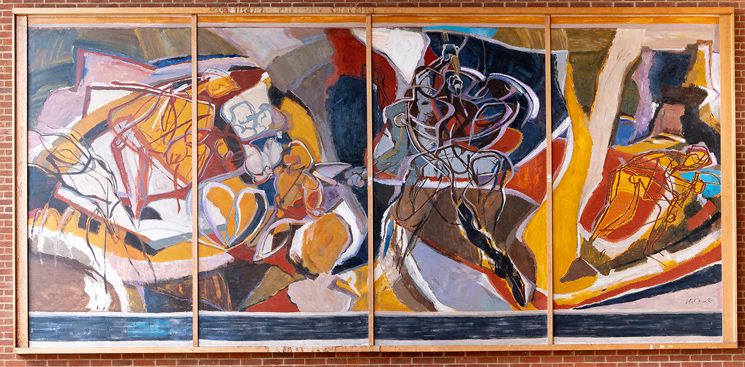
The largest work of art at Sussex is a giant wax and oil abstract mural by Ivon Hitchens (1893-1979), which dominates Mandela Hall in Falmer House.
Hitchens gifted the work, Day’s Rest, Day’s Work, soon after he visited the University during its construction in 1962. He was so enamoured with what he saw that he told architect Sir Basil Spence that if he were an undergraduate, he would like to have studied at Sussex.
A member of the celebrated London Group of artists, Hitchens exhibited in London in the 1920s and 1930s and moved to Sussex near Petworth with his family after his London studio was bombed in 1940. He represented Britain at the 1956 Venice Biennale. The rolling hills, woodland and heathland of the Sussex Downs were his main inspiration.
Granite tortoises outside Arts A
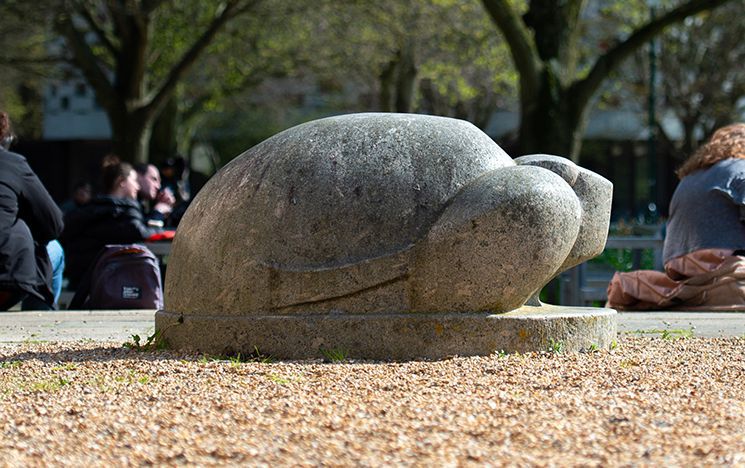
As is often the case with tortoises, these two were believed to be ‘missing’ for several decades.
The two-and-a-half tonne granite sculptures were originally made by John Skeaping (1901-1980) for a children’s adventure camp, known as the Isle of Thorns, on the edge of the Ashdown Forest near the Kent/Sussex border.
The University acquired the sculptures after buying the freehold of the property in 1992. Although the property was sold in 2002, the tortoises were not part of the sale. Instead they were brought to campus as a memento of the University’s connection with the Isle of Thorns. Thanks to some surprising communication between the University and Skeaping’s son Nicholas, their provenance was rediscovered.
John Piper tapestry
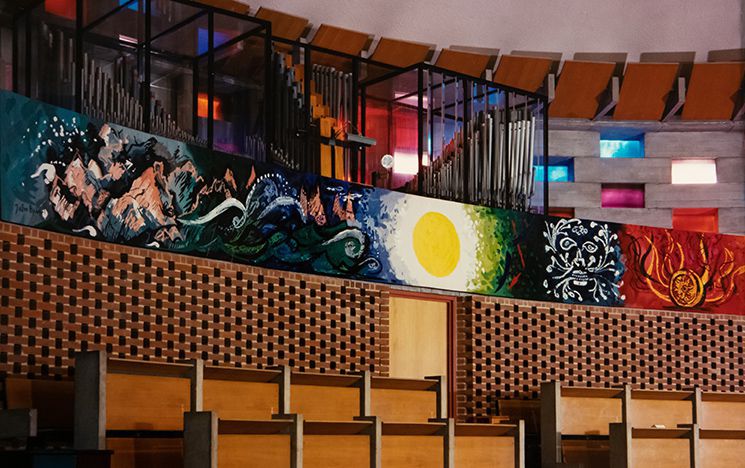
Among the many treasures in the Meeting House is a John Piper (1903-1992) tapestry, commissioned in 1976 for the 10th anniversary of campus’s architectural gem.
The tapestry adorns the organ loft and was inspired by the University’s motto ‘Be still, and know’, which is taken from Psalm 46. Its colours echo the honeycomb of coloured glass panes in the Meeting House, while its design depicts the vivid imagery in the psalm of “mountains carried into the midst of the sea”, a raging “heathen” and “the chariot in the fire”.
Piper, who lived in Sussex, produced a number of celebrated works in a variety of materials, from stained glass to sketches and tapestries, and was an official war artist during the Second World War. A number of years ago the Meeting House tapestry was stolen, later turning up at an auction house. Luckily the auctioneer recognised it was a special work of art and contacted the police. It’s now back in situ, securely alarmed.
Lord Attenborough portrait in ACCA
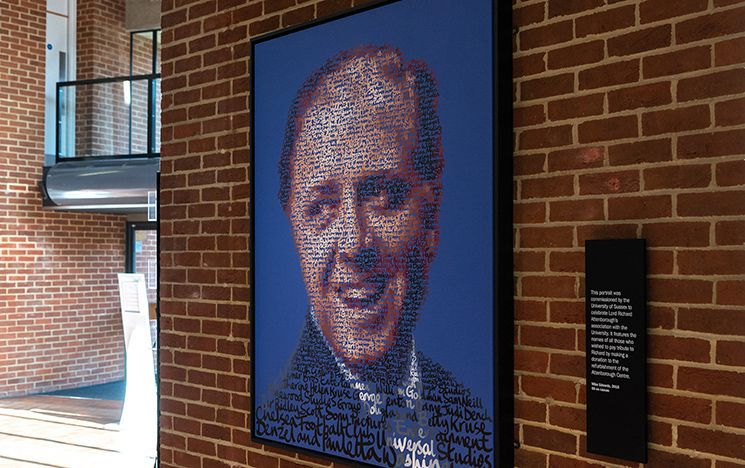
Lord Attenborough’s face as a young man beams from the portrait of him that has pride of place in the Attenborough Centre for the Creative Arts on the University’s campus. If you look closely you can see a whole host of other famous names.
Dame Judi Dench, Dame Maggie Smith, Michael Douglas and the broadcaster Channel 4 were among people and organisations who pledged their support for the refurbishment of the Gardner Arts Centre, which was reopened and renamed in commemoration of the University’s former Chancellor and celebrated actor and director in 2016.
The work was created by Brighton artist Mike Edwards, a pioneer of typographical art, who has created similar-style portraits of icons including Blondie and David Bowie. The paintings are composed of clearly readable text that, when viewed from a distance, merges to create an image with a photographic-like quality.
Postcards curated by Jeremy Deller
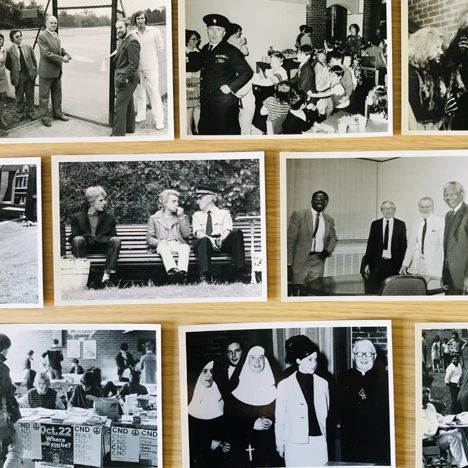
For our 50th anniversary in 2012 Turner Prize-winning artist and Sussex alumnus Jeremy Deller celebrated the provocative and off-beat side of campus life in a series of 50 postcards inspired by the University’s photo archives.
The postcards – featuring moments from the University’s first 50 years – included one of former Vice-Chancellor Alasdair Smith and former Lewes MP Norman Baker riding a tandem on campus as a stunt for a “no cars” day.
Jeremy, who studied art history at Sussex, is celebrated for work that includes the re-enactment of a violent clash between police and miners during the 1980s strikes (The Battle of Orgreave), the exhibiting of a bomb-blasted wreck of a car taken from Iraq (It Is What It Is) as well as the video study of George Bush's home state that won him the Turner prize in 2004.
Christ’s Entry into Brighton
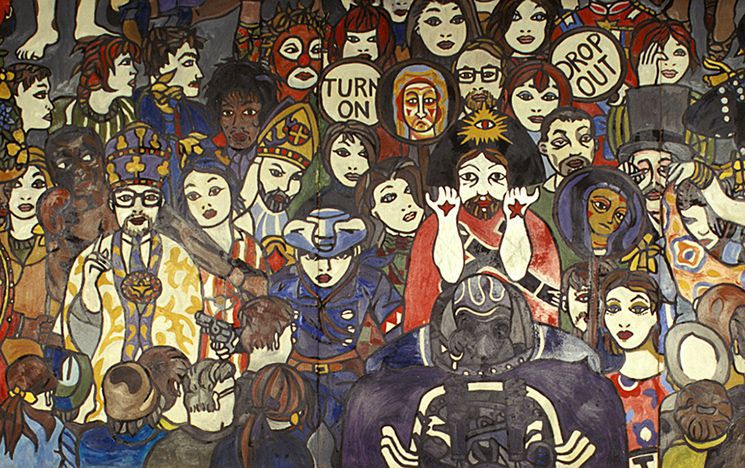
In 1966, Timothy Leary coined the phrase of the decade: “Turn on, tune in, drop out.” In 1967, while artist in residence at the University of Sussex, John Upton (1933-2005) incorporated those immortal words in his work, Christ’s Entry into Brighton.
Celebrated for capturing the spirit of the age, the oil on hardboard piece features famous and infamous faces from the Sixties, such as Christine Keeler, Harold Macmillan, Batman, and Jimi Hendrix – as well as students and faculty members known to the artist.
The work, which is on display in A155, is one of several by Upton in the University’s possession. Others include Nude with Mirror (1969) and And She Was The Princess (1969).
It also inspired other works that have been co-created on campus by artists and students. They include a giant painting by International Relations students, now hanging in a stairwell in Arts C, titled The Great Cacophany of International Relations. And a mural in Fulton Building, created by students with an artist, the making of which was captured on film to celebrate the University’s 50th anniversary in 2011.
Henry Moore sculpture
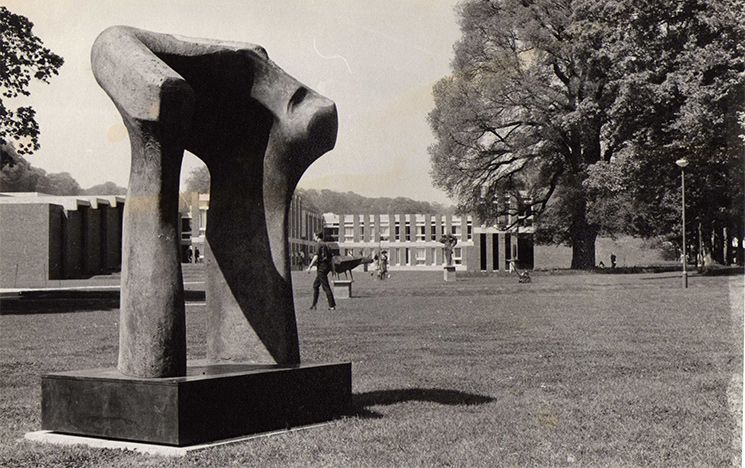
In 1965, campus was the venue for a touring Arts Council sculpture exhibition, which included works by the celebrated artists Henry Moore and Barbara Hepworth.
The same year, Moore received an honorary degree from Sussex. His work, a bronze arch that is referred to as Torso, remained on campus for a while afterwards, taking up various different locations on the grassy areas between the Library and the Meeting House.
Occasionally used as a perch for bottoms, as well as being the centrepiece of a short film, entitled Fire over Falmer, in 1967, it quietly left campus for new pastures in 1968. Read more about it here.